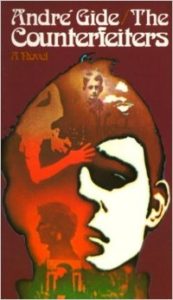 Makers of false coins are not the counterfeiters that most concern André Gide in his novel The Counterfeiters (Les Faux-Monnayeurs). The counterfeiters that matter most are the writers: the character Édouard, the narrator who speaks for Gide, and even Gide himself. The fictional Édouard writes at length in his journal about a book he is planning to write, a book called The Counterfeiters, which shares not only the same title as Gide’s novel, but also its subject and themes. Nevertheless, The Counterfeiters is not a book within a book as many critics claim because the reader is never allowed to read Édouard’s novel, only his notes.
Makers of false coins are not the counterfeiters that most concern André Gide in his novel The Counterfeiters (Les Faux-Monnayeurs). The counterfeiters that matter most are the writers: the character Édouard, the narrator who speaks for Gide, and even Gide himself. The fictional Édouard writes at length in his journal about a book he is planning to write, a book called The Counterfeiters, which shares not only the same title as Gide’s novel, but also its subject and themes. Nevertheless, The Counterfeiters is not a book within a book as many critics claim because the reader is never allowed to read Édouard’s novel, only his notes.
Yet if Édouard is a stand-in for the narrator, an alter ego of the author, we could say that we are reading Édouard’s book when we read Gide’s novel, except that the author distances himself from the character in several ways: “by the use of a forename that distinguishes the vicarious novelist from his creator; by Gide’s refusal to delegate to his counterpart all of the conduct of the narration; by the decisive way the author criticizes as Utopian the quest for a reconciliation between realism and the ‘pure novel’; . . . and by the place reserved in the finished novel for ‘real facts’ (news items taken from press reports — the discovery of the counterfeit coin, Boris’s suicide), which Édouard criticizes, confessing that they make him feel ‘uncomfortable,'” (33) writes Lucian Dällenbach in The Mirror in the Text (which gave me the title for this series).
Édouard is uncomfortable because the “real facts” do not exactly coincide with his record of the events; he is forced to recognize that he has necessarily falsified events, producing a counterfeit of the truth, which is why the narrator criticizes Édouard for imagining a pure, realistic novel.
The novel Édouard imagined, however, is perfect because it is never written down. Gide’s book is imperfect because it was. Gide wrote the novel that Édouard describes, but it was an approximation, an imperfect version of “the pure novel” his character proposed, a counterfeit of an unwritten, fictional book.
In The Merriam-Webster Encyclopedia of Literature, we read, “Edouard . . . observes that if a counterfeit coin is thought to be authentic, it is accepted as valuable; if it is found to be counterfeit, it is perceived as worthless. Therefore, he concludes, value is wholly a matter of perception and has nothing to do with reality.” Neither Gide nor Édouard write the pure novel, yet if they can create an image of that novel in the reader’s mind, then perhaps the novel inside (or beyond) the novel becomes valuable and authentic, even if it is a counterfeit.
(Read more about “the mirror in the text” in my next post in this series: Into the Abyss: The Mise en Abyme, the Art Work Within the Art Work.)
Work Cited
Dällenbach, Lucien. The Mirror in the Text. Chicago: The University of Chicago Press, 1977.
Gide, André. The Counterfeiters. Trans. Dorothy Bussy. New York: Vintage, 1973.
“The Counterfeiters.” The Mirriram-Webster Encyclopedia of Literature. Springfield: Mirriam-Webster, 1995.
2 thoughts on “A Book Within a Book in The Counterfeiters: The Mise en Abyme”